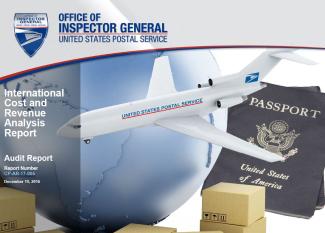International Cost and Revenue Analysis Report
Background
The Postal Accountability Enhancement Act of 2006 (PAEA), Section 3652, requires the U.S. Postal Service to “analyze costs, revenues, rates, and quality of service” and submit an Annual Compliance Report to the Postal Regulatory Commission (PRC) no later than 90 days after the end of each year.
The PAEA also requires the Postal Service to annually report costs, revenue, volumes, and quality of service to the PRC. The PRC uses the information in these reports, including the International Cost and Revenue Analysis (ICRA) report for international products, to determine whether the Postal Service complied with the statute.
The Postal Service maintains a product costing system designed to comply with the PAEA, develop product costs, and generate information to support management decisions.
Because Postal Service accounting systems do not provide all required product information for reporting purposes, the Postal Service employs various statistical systems and special studies to generate the ICRA.
The Postal Service relies primarily on the In-Office Cost System (IOCS) for ICRA data collection for mail processing. The international mail tallies obtained from the IOCS generate international mail processing and acceptance costs. Other inputs are produced from a variety of source data, including certain accrued cost totals and distribution keys (used to assign volume related costs to products) that derive from operating and administrative functions. These various data sources are presented in the ICRA report as international costs associated with mail processing, delivery, and administration (non-transportation).
Domestic transportation costs for the ICRA are developed from the accrued costs obtained from the books of account for the various transportation modes (air, rail, or highway) on the basis of volume statistics. The volume statistics are obtained from the Transportation Cost System, which is a field data collection system operated for this purpose.
Our objective was to assess the accuracy and completeness of non-transportation processing and domestic transportation costs for Inbound Single-Piece First-Class Mail International as reported in the ICRA report for fiscal years 2014 and 2015.
What the OIG Found
The Postal Service accurately reported non-transportation processing and domestic transportation costs for Inbound Single-Piece First-Class Mail and determined the costs were complete.
However, the Postal Service needs to strengthen the current documentation used in developing the ICRA report by integrating the core documents used to produce the ICRA report into a consolidated ICRA user guide.
The Postal Service believed it had sufficient documentation to prepare the ICRA report because the NP-5 document (an overview and technical description of the ICRA) included process flow charts and descriptions of the various calculation spreadsheets.
Without a consolidated ICRA user guide that integrates and links the two components of the NP-5 document with the 22 internal sheets (tabs) in the ICRA report, it is difficult for the Postal Service to ensure that strong, complete ICRA documentation is available to prevent the risk of miscalculations, inaccuracies, and inconsistencies in the ICRA report.
In addition, the Postal Service's distribution approach for its 600,000 annual IOCS employee samples does not efficiently capture costs in all categories, resulting in oversampling by at least 30 percent. A more efficient approach would save the Postal Service about $3.8 million annually in labor costs without significantly changing its sampling results.
What the OIG Recommended
We recommended management develop a detailed, documented, and consolidated user manual to consistently prepare the ICRA report and prevent loss of institutional knowledge. We also recommended management revise its sample distribution approach to more efficiently capture all costs.

